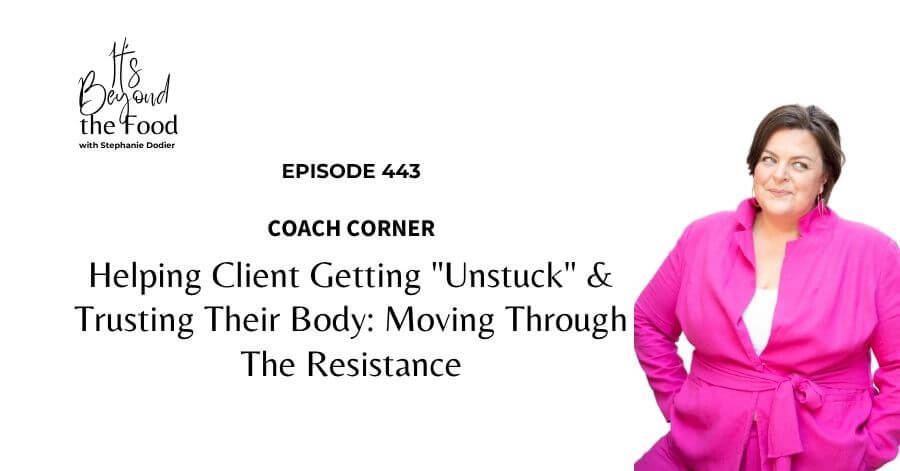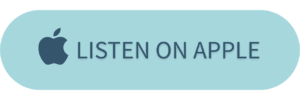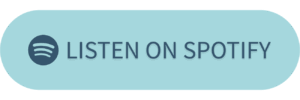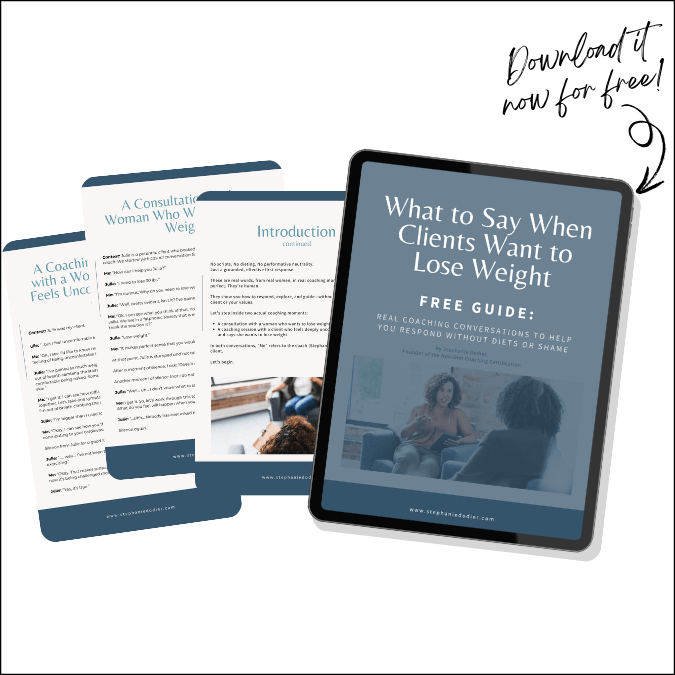

Ever had a client say, “I feel stuck”? Or maybe you’ve felt that way yourself. In this episode of Coach Corner, I dive deep into what “being stuck” really means in coaching. I’m sharing practical, mindset-based tools you can start using right away to help your clients shift out of stuckness and into movement—without pushing past their emotional safety.
You’ll also hear how resistance shows up in coaching sessions, especially when clients are learning to trust their bodies. I’ll break down how to work through that resistance using a compassionate and cognitive behavior-based approach. Whether you coach on eating behavior, body image, or mindset, you’ll walk away with tools to coach better, faster, and with more impact.
Episode Highlights & Timeline:
[2:00] – What “I feel stuck” really means in cognitive behavior coaching
[4:00] – How safety plays a key role in client growth and discomfort
[5:40] – Real-world examples: stuckness in intuitive eating and body image work
[7:12] – A simple method for helping clients feel safe again
[8:31] – Using self-coaching and self-compassion to support stuck clients
[9:35] – Understanding resistance to body trust and why it shows up
[12:00] – The “minimum baseline” strategy to move clients forward gently
[14:11] – Building self-trust that expands beyond food and body
Mentioned in the show:
Non-Diet Coaching Certification Waitlist
Stephanie’s Coach Corner Vault
Full Episode Transcript
This transcript was auto-generated and lightly edited for clarity.
Click to expand the full transcript
How do you coach clients to trust their body after diet culture?
To coach clients to trust their body after diet culture, start by normalizing their fear and resistance. Use cognitive behavior coaching to reframe negative thoughts and identify the root of their distrust. Introduce small, safe steps—like responding to hunger cues or wearing clothes that fit—while using nervous system regulation techniques, such as self-compassion and grounding. Build trust gradually through consistent, supportive coaching focused on self-trust and safety—not weight or control.
[00:00:00] Welcome to It’s Beyond the Food Podcast, my sisters. I’m your host, Stephanie Dodier, and today we’re back with episode two of our new series called Coach Corner and this series for all my Health Professional that are following me, listening to our podcast, dietician therapist coaches who are learning and want to get better at coaching using cognitive behavior coaching.
[00:00:23] Without co-opting diet culture. So each episode is designed to answer two question short and focused to give you answers and application you can do right away with your client. Now, before we dive in. I have an announcement to make. We created something really cool and we pull this together very quickly to be ready.
[00:00:48] On episode two, it’s called the Coach Corner Vault. So the Coach Corner Vault gives you access to over 50 live mini training that I have [00:01:00] done over the year. We pulled it all together on a Google sheet with the URL link, and they’re mainly coming from my Instagram account, as you probably know I’ve been at this for about nine years now, so over the years I’ve done a lot of lives that will give you training on mindset coaching, using cognitive behavior coaching, body image, eating behavior, and also some business mindset coaching.
[00:01:30] And it’s an on-demand library. You will see the title, you will see the topic, and be able to select what you’re listening to. Isn’t it cool? So if you want Access the Coach Corner Vault, you can go to the show notes attached with this podcast on whatever platform you’re listening to. Or you can go to our website, ww dot stephanie dosier.com/coach corner.
[00:01:59] Now [00:02:00] we’re back to the regular Coach Corner here series on a podcast, and we’re gonna answer the question, how to help client that feel stuck. And perhaps this is gonna help you to, because you have the thought, I am stuck. Okay, so the first thing I wanna do is to normalize this thought. I am stuck because we and our client will feel frozen.
[00:02:31] We’re not moving fast enough towards our goal. Nothing is changing. Like we have this perception that nothing is changing, and now we’re stuck because everything we’re trying is not working. So the first thing I wanna say is nothing has gone wrong. It is totally normal for your client to feel stuck. It’s totally normal for you to even analyze your situation as I am stuck, but nothing has [00:03:00] gone wrong.
[00:03:02] In the world of cognitive behavior coaching, we consider this a thought, I feel stuck. I am stuck. It’s an opinion that you have on the current circumstance you are experiencing, and you are assessing it as you being stuck. So I wanna offer you the lens of cognitive behavior coaching of what it is truly.
[00:03:30] If it’s not being stuck, if it’s not that things have gone wrong because truly nothing has gone wrong, what is it? In a world of cognitive behavior, coaching and also nervous system regulation, being stuck simply means that you have reached the edge of what feels safe for you. Very often people will consider that
[00:03:54] The comfort zone. We’ve reached the edge of our comfort zone from a nervous system [00:04:00] somatic angle, we’ll call that feeling safe. You’ve reached the edge of evolution, of growth, of change that feels safe for you, so it’s a signal. When we hear our clients say that we don’t perceive it as the truth, we perceive it as, oh, okay, my client has reached the edge of their safety capacity right now.
[00:04:23] And when we can see it like that as coaches, we can then find a very quick solution. We can find a way for our client to feel safer with the discomfort of the behavior change your client is going through right now. So how do we take that into our client session? The number one thing is for you to understand what I just taught you here
[00:04:49] what is really happening? Nothing has gone wrong. You’ve reached the edge, the capacity that you have to feel safe. You’ve reached the edge of your comfort zone right now. [00:05:00] Nothing has gone wrong. It’s totally normal as we create a new behavior. It is normal for your body to see this new behavior as something that is likely to create danger, to feel like a threat.
[00:05:16] And I’m gonna give you two example here and I’m gonna give them to you in the context of first eating behavior. So when we help our client move from restrictive eating to intuitive eating, very often that requires for the client to eat more food because very often former Dieter were undereating.
[00:05:40] So when they’re starting to listen to their hunger cue, they will eat more food. And that feels like a threat for them. Their nervous system thinks, oh my God, what’s happening? We’re losing control here. We’re actually eating more food than we’ve done in a long time. So that would be the angle of
[00:05:59] eating [00:06:00] behavior. If you’re looking at it from a body image coaching, we often feel the stuckness when we move to step number three of the body image coaching process, where we’re actually starting to take action, like buying clothes that actually fit our body or wearing more fitted clothes or clothes that are more what we want our style to be, more colorful, more noticeable and our client will get to that edge where it feels like a danger.
[00:06:31] Because if they go out there with a, I don’t know, a bright pink dress, people will notice them. And the risk of receiving body comments. So there’s a threat there perceived by the brain. So explain it to your client. What is happening, what it is really about. They’re not stuck, nothing has gone wrong.
[00:06:51] They’ve just reached their edge of safety. And then the work to get unstuck, and I’m using Air quote, if you’re not listening to me on YouTube, [00:07:00] is to actually coach our client through the process of creating safety. So how do we do that? Number one step is normalizing. So explaining to our client what’s happening.
[00:07:12] Naming things, explaining things we’re not stuck. Safety the number one way simplified here on this podcast way of creating safety. Is something called resourcing out using the self-compassion model. I’m gonna describe it in case you are listening on the podcast, i’m putting my two hands stack on top of each other on my chest right now,
[00:07:37] and I’m connecting with my body to a very slight pressure on my body, on my chest, with my hand, and taking a deep breath quickly, scanning my body going into our body is something that creates safety. Because when we feel stuck, we’re in our head, not in our body. So I’m like [00:08:00] connecting my body, connecting by putting a little bit of pressure with my hand and I’m gonna talk to myself.
[00:08:06] I’m gonna coach myself. It could go something like this. It makes total sense for me to think right now I am stuck, that something has gone wrong in the intuitive eating process. So it makes total sense for me to feel anxious. Right now, I feel it in my body. I feel afraid it makes total sense, but actually what’s happening is that I’m growing.
[00:08:31] I’m expanding into new eating behavior. I’m learning to trust my body, and that feels unsafe. Right now.
[00:08:42] I’m learning to trust myself. That’s it. That’s a very simple way for you to teach your client to create safety through the concept of self coaching. So if I recap this feeling stuck is [00:09:00] totally normal, nothing has gone wrong, it’s a sign for you as a coach that your client needs to level up their feeling of safety.
[00:09:10] Moving on to question number two, and it’s gonna build up on what I just, the question is, how can I help my client through their resistance of trusting their body. Many of my clients say to me, is there another way that would require me to trust my body, which has failed me for years?
[00:09:35] The number one thing I wanna teach you on this is that resistance in the world of cognitive behavior coaching versus an emotion that your clients are experiencing, they’re experiencing resistance, they’re resisting the task of learning to trust their body, or they’re resisting deepening their trust for their body.[00:10:00]
[00:10:00] That resistance is created because of the opinion, the thoughts that they have of the concept of trusting their body, and very similar to feeling stuck when people experience resistance. It’s often because they don’t feel safe. They have thoughts around trusting their body that is a threat to their brain and to their nervous system.
[00:10:26] It’s danger, it’s their thinking. It’s gonna lead them to a place where they absolutely do not want to go because it’s highly unsafe and truth be told very often it’s the fear of weight gain. Because in a world that idolize and that platform and value thin body, the thought of gaining weight because you’re trusting your body for an example with food is
[00:10:57] life-threatening. There are risking [00:11:00] rejection. They are risking judgment. They are risking even access to healthcare, right? Like it’s not just. Interpersonal risk, but it’s also actual real foundational access to their basic needs that being at risk. So all of these thoughts are running into the brain of your client and the safety mechanism in order for them to not go there, not create this risk is resisting.
[00:11:35] It’s. Other words feeling stuck.
[00:11:39] So how do we coach this? Number one, we name it. We say, okay, in cognitive behavior coaching model. We’ll do an unintentional model, we’ll gather the thoughts of our client, their feeling, their emotion, their behavior, their response to these emotion, and we’ll describe it to them.
[00:11:58] Here’s what’s happening. You’re thinking this, you’re [00:12:00] feeling this. And this is why you are resisting. That’s why you’re having the behavior of resistance and not wanting to move forward because you’re afraid, because you’re thinking this is what’s gonna happen. So name it two, normalize resistance. I often say to people, stop ing resistance.
[00:12:18] Lean in to the resistance experience and learn from it. What is there for you to learn in this experience of resistance? And often it’s discovering their thoughts and their cognitive dissonance, their fear, their catastrophization of the situation, their black and white thinking of what could potentially happen if they lean in more to trusting their body.
[00:12:46] Step three use a concept called minimum baseline, where we take the smallest level of action they can take towards, in this case, trusting their body [00:13:00] and creating safety for that minimum baseline action. And it’s very important and I’m assuming it’s already part of your coaching process, that we do one circumstance at a time.
[00:13:11] So if we’re coaching food, we’re not at the same time demanding that our client work on body image, that would be overwhelming, and that is why your client’s nervous system is over capacity. Within the circumstance that you’re working for. An example, if you’re building up the capacity to eat when you’re hungry, take the smallest action they can take,
[00:13:34] so if they feel hungry, eat a small amount of food, build it up to their capacity to fully respond to their hunger signal, build safety through the minimum baseline action they can take.
[00:13:53] Step four, keep building up right as you build safety to do the minimum baseline [00:14:00] action they can take. The next time we build that minimum baseline action to be slightly bigger and slightly bigger. So with each, I want you to think of a ladder, which each.
[00:14:11] Wrong on the ladder. As they’re going up, they’re building up their capacity to feel safe, taking bigger action, and ultimately leading them to trust their body. Now, I’ll give you a bonus step. Draw the big picture for your client as they’re working through an example, trusting their body with food. Lay out the picture that, yes, you’re working with food right now, but the ultimate outcome will be self-trust towards their whole life.
[00:14:44] As we’re doing it with food, we’re gonna do it with our body and the way our body look. We’re gonna do it with self-care, we’re gonna do it with health promoting behavior, and then it’s gonna expand to your whole life where you can trust yourself and your relationship in your [00:15:00] workplace. Like it’s going to expand, it’s gonna be contagious, and that’s where you’re gonna get to a place of.
[00:15:06] Confidence because that’s the outcome of self trust is confidence. So helping your clients see the bigger picture often creates intrinsic motivation for them to keep going and moving through the discomfort.
[00:15:20] So if I was to give you a takeaway, resistance is a very positive sign that your client is actually moving through expansion and creating new behavior, and it’s totally part of the process of behavior change. If this is the kind of coaching you want to master, rooted in behavior, change, self-trust, and a weight neutral approach to health, that’s exactly what I teach inside of the non diet coaching certification.
[00:15:52] Get your name on the wait list for the next cohort. Until next time, my sister coach behavior not [00:16:00] bodies, and I’ll see you in the next episode.
[00:16:06] wanna coach behaviors, not bodies. Learn the mindset tool and the method that create real changes.
[00:16:14] Join the wait list for the next cohort of the non diet coaching certification at stephaniedodier.com/waitlist. That’s where the real training begins, and I’ll see you on the other side, my sisters.







